Over the past couple of years, there’s been quite an uptick in the number of devices dedicated to on-the-go gaming. Perhaps the Steam Deck is partially to blame for this, but instead of being powered by Windows or SteamOS, there are a bunch of Android gaming handhelds.
Ayaneo is one of these companies leading the way, taking its experience from Windows handhelds and attempting to make waves in the Android handheld space. The Pocket Air is Ayaneo’s first foray into Android gaming handhelds, offering a unique take in more ways than one.

Ayaneo Pocket Air: Price and availability
(Image credit: Andrew Myrick / Android Central)
The Ayaneo Pocket Air was originally announced in August 2023 before it was officially released in September 2023. Initially, it was available through an Indiegogo campaign, coming in a few different configurations. Now, the Pocket Air can be purchased directly from the Ayaneo website.
When announced, three different configurations were available, starting with the 6GB/128GB model for $299 and maxing out with 12GB of RAM and 512GB of storage. Currently, the 8GB/256GB variant has been sold out for some time, but the 12GB/512GB version can be had for $399.
Ayaneo Pocket Air: What I like
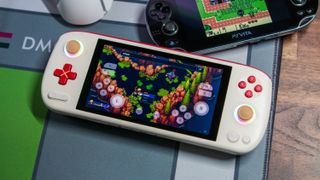
(Image credit: Andrew Myrick / Android Central)
It’s not like the Pocket Air was the first gaming handheld to hit the scene, but something that has helped it stand out is the 5.5-inch OLED display. This, paired with the retro-inspired colorway, makes for an intriguing handheld gaming solution.
Keeping with the design, there are slight bump-outs on the left and right sides, offering some decent ergonomics. It pales in comparison to the likes of the Steam Deck or Lenovo Legion Go, but at least it’s not another Pimax Portal or Nintendo Switch situation.
Besides that, the Pocket Air has all of the buttons you’d expect from a gaming handheld, with a few extras. First, the two buttons in the bottom right corner operate as shortcuts. The larger of the two activates a panel that slides in from the right, where you can quickly view and change performance or fan profiles on the fly. Meanwhile, the smaller button simply takes you back to AyaSpace, the company’s proprietary launcher.
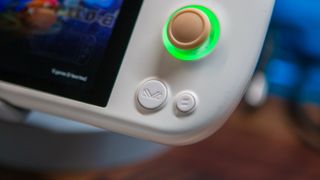
(Image credit: Andrew Myrick / Android Central)
Last, but certainly not least, there are a couple of extra tricks that the Pocket Air has up its sleeve. For one, the power button doubles as a fingerprint scanner, which is great for jumping back into a game quickly without entering a PIN or drawing a pattern.
Swipe to scroll horizontallyCategoryAyaneo Pocket AirDisplay5.5-inch OLEDResolution1920 x 1080Refresh RateUp to 60HzProcessorMediaTek Dimensity 1200RAM6GB / 8GB / 12GBStorage128GB / 256GB; expandable via microSD cardConnectivityUSB 3.2 Gen 1 Type-C / 3.5mm headphone jack / Wi-Fi 6 / Bluetooth 5.2 / LTEExtrasExtras: Hall joysticks and triggers / Fingerprint scannerBattery7,350mAhDimensions224 x 89.5 x 17mmWeight380g
My favorite “trick” of the Pocket Air comes via the pull-out tray on the bottom. Not only is there a microSD card slot, which is important if you have a massive library of games, but if you flip the pull-out microSD card tray over, you’ll see a cutout for a tiny card. That’s right; you can pop a SIM card into the Pocket Air and play games literally anywhere without being tethered to Wi-Fi.
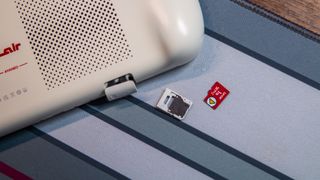
(Image credit: Andrew Myrick / Android Central)
As for performance, MediaTek’s Dimensity 1200 can handle pretty much anything that you throw at it. This includes the likes of PS2, GameCube, and even some Switch games, especially if you opt for one of the higher-end models that are equipped with more RAM.
Don’t expect to emulate Tears of the Kingdom here, but for lighter-weight titles, the Dimensity 1200 barely breaks a sweat. It’s also worth pointing out that thanks to the massive fan cutout and active cooling system, I never once felt the Pocket Air get too hot to hold.
Ayaneo Pocket Air: What I don’t like
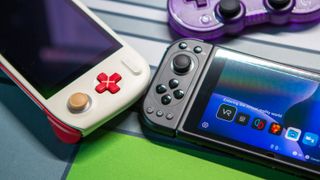
(Image credit: Andrew Myrick / Android Central)
I previously mentioned that it’s possible to emulate Switch games on the Pocket Air. While that is technically true, the Dimensity 1200 just isn’t powerful enough for higher-end Switch titles. Compounding the limitations of MediaTek’s chip is the lack of third-party driver support.
While MediaTek chips are more affordable compared to Qualcomm, the latter is still preferred due to better community support. MediaTek processors are fairly “locked down” in this regard, making it more difficult for custom drivers to be created that support the various chips.
Frankly, it’s a bit disappointing to see, especially when you consider that some MediaTek processors outperform Qualcomm equivalents in “raw” power. However, if the power can’t be optimized properly, then those performance differences aren’t available and shouldn’t be included in your decision-making.
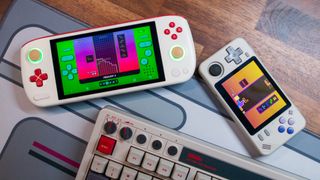
(Image credit: Andrew Myrick / Android Central)
All of that being said, there’s a pretty good chance that you aren’t going to try to push the Pocket Air to the absolute limits. However, it’s still something to keep in mind so you better understand what’s possible.
While it probably won’t be a dealbreaker for those who plan to play retro games, it is disappointing to see the refresh rate capped at 60Hz. At the very least, I think the Pocket Air should have featured a 90Hz refresh rate, even if the company didn’t (or couldn’t) match the likes of the Razer Edge.
One of the problems with the Pocket Air at launch was that you couldn’t remap on-screen controls to the built-in controller. Thankfully, this has been remedied via subsequent software updates. However, I’m still not the biggest fan of the AyaSpace launcher and interface. Thankfully, there are a few alternatives that work quite well, including ES-DE, Beacon, and Daijisho.
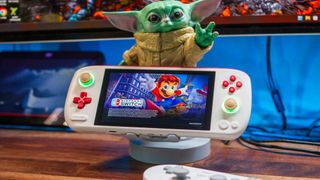
(Image credit: Andrew Myrick / Android Central)
Lastly, I’ve come to find that the D-Pad on the Pocket Air is just a bit too mushy for my taste. It’s almost like the Pocket Air and Pimax Portal are at complete opposite ends of the spectrum.
The problem is that with a mushy D-Pad, there have been times when I’m playing Apotris or older Tetris games, and the pieces are one or two slots off from where I was trying to place them. This isn’t an issue during the early levels, but it’s definitely frustrating when the pieces are flying down and one wrong move ends a run prematurely.
Ayaneo Pocket Air: The competition
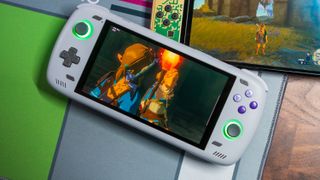
(Image credit: Andrew Myrick / Android Central)
It seems that Ayaneo is attempting to take over the Android gaming handheld space, and it all started with the Pocket Air. Since then, the company has announced the Pocket S, along with the Pocket DMG and Pocket Micro. However, at this price point, Ayaneo’s stiffest competition comes in the form of the AYN Odin 2 and Odin 2 Mini.
The Odin 2 and Odin 2 Mini are powered by the Snapdragon 8 Gen 2, making it more powerful than the Dimensity 1200. As mentioned previously, this also means that there is better driver support for emulators. Then again, neither the Odin 2 nor Odin 2 Mini are equipped with an OLED display, giving the Pocket Air a pretty clear advantage.
There’s also the Pocket S, which was announced last year and is one of a handful of devices to be powered by the Snapdragon G3x Gen 2. However, it won’t take long for you to see that the Pocket S offers a more premium design. With that comes a higher price tag, starting at $589 for the base model.
Ayaneo Pocket Air: Should you buy it?
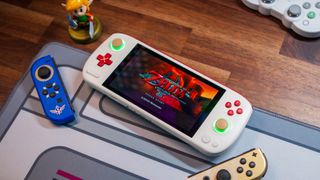
(Image credit: Andrew Myrick / Android Central)
You should buy this if:
You’re looking for a good and powerful starter Android gaming handheld. You want a handheld with an OLED screen. You don’t want to spring for a Steam Deck or ROG Ally X.You want a handheld with LTE connectivity and expandable storage.
You shouldn’t buy this if:
You’re on a budget.You want the most powerful Android gaming handheld.
Ayaneo got a lot of things right with the Pocket Air, as it’s one of a few handhelds that sport an OLED display. Plus, it’s currently one of two handhelds that allow you to use it with a SIM card, with the other being the Razer Edge. However, it seems that the Edge is getting phased out as it’s becoming more difficult to purchase, and a successor has not been announced.
With that in mind, the Pocket Air is a great entryway into the Android handheld scene, especially for beginners or those who have no interest in higher-end emulation. It’s comfortable to hold and offers great battery life. Even if you aren’t a fan of AyaSpace, you can download a different launcher.
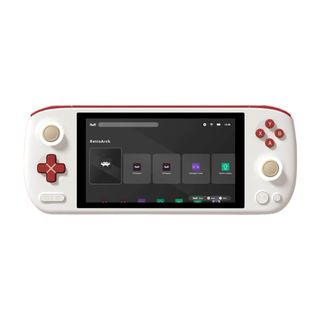
Retro-inspired
Although the market is growing for Android gaming handhelds, the Ayaneo Pocket Air is a good starting point. For $300, you get solid performance, an OLED screen, and even the ability to pop-in a SIM card to game on the go.





GIPHY App Key not set. Please check settings